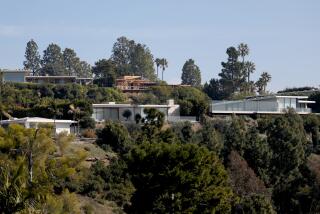In Beverly Hills, the real estate ethos is ‘buy and demolish’
In most places, an 8,100-square-foot house with five bedrooms, six baths and a swimming pool that had been remodeled by a master architect would be considered the height of luxury.
And if Ira Gershwin had penned lyrics for such standards as “The Man That Got Away” during the decades he lived there, all the better.
Not so much in Beverly Hills, a city of stratospherically priced property, where many residents prefer to build their castles from scratch — and have the scratch to build exactly what they want.
PHOTOS: Former Ira Gershwin home
The recent demolition of a North Roxbury Drive residence where Gershwin lived, wrote and entertained Hollywood royalty is just the latest example of how difficult it can be to preserve the past in a city where residents are accustomed to doing as they wish.
Beverly Hills offers a trove of distinctive homes designed by noted architects, many with legacies that date to Hollywood’s Golden Age. But architectural and cultural heritage has often proved no match for the nouveaux riches of Beverly Hills.
“Tastes have changed,” said Stan Smith, managing director of Teles Properties, a high-end real estate firm. “The kinds of houses people want today aren’t reflected in the old stock.”
Some of the older homes lack the style and amenities today’s luxury buyers want — great rooms, entertainment centers, cavernous closets, restaurant-quality kitchens and vast bedroom suites. Rooms in even the most opulent of older Beverly Hills homes can feel cramped by modern high-end standards.
Perhaps no one has torn down and rebuilt more homes in Beverly Hills than Hamid Omrani.
The Iranian-born Omrani, who estimates he has designed 150 houses in the city, said many of his clients dislike the Spanish, Tudor and other revival styles of Beverly Hills’ early homes. For them, remodeling is unappealing. They want to maximize home size, often reducing outdoor space in favor of more bedrooms and more expansive living areas.
“They prefer to buy and demolish,” he said.
For the year to date in Los Angeles County, Beverly Hills 90210 has the second-highest median price ($2.6 million) for existing single-family homes in Los Angeles County, after only Santa Monica 90402 ($2.9 million), according to DataQuick, a real estate firm based in San Diego.
The tear-down phenomenon is hardly new. Beverly Hills residents have for decades razed houses that earlier generations considered grand to make way for more lavish residences, many of them stucco-and-glass boxes with the vague aura of Italian villas.
They featured flat roofs, second-floor balconies with tall windows, soaring entry doors embellished by metalwork and columns, lots and lots of columns. Collectively, these houses took on the sobriquet “Persian palaces” because they appealed to the Iranian-born families that are estimated to make up more than one-sixth of Beverly Hills’ 34,000 residents.
Initially, many of these new manses overwhelmed their neighbors, but now they have plenty of imposing company.
Many structures associated with celebrities or designed by noted architects were among those toppled by bulldozers, including John Lautner’s curvaceous Shusett House. After a home created by modernist Richard Neutra came perilously close to meeting that fate, Beverly Hills finally got serious about preserving its architectural and cultural legacy.
The city enacted an ordinance early last year, then quickly embraced tax breaks to foster neighborhood preservation and designated 14 local landmarks, including the Beverly Hills Hotel, Greystone Mansion, the Witch’s House and City Hall. The city is also conducting a citywide survey to identify potentially significant houses.
In Trousdale Estates, where early homes were designed by Paul Revere Williams, Wallace Neff and Harold Leavitt, “we found 200 properties of note, out of 535,” said Steven M. Price, a historian who is helping to conduct the inventory.
The actions have pleased critics who had long deemed the city too willing to sacrifice significant structures to make way for mixed-breed palazzos or undistinguished apartment buildings. Others say it is unfair to dictate what an owner may or may not do to his property.
The Ira Gershwin house fell between the cracks, city officials say.
The now-leveled house at 1021 N. Roxbury Drive was decidedly “old stock.” Lyricist Gershwin and his wife, Lee, hired John Elgin Woolf to extensively remodel the house in his trademark Hollywood Regency style. Because Woolf appears on the city’s list of local master architects, the demolition application should have been flagged for further review. But city employees who granted the permit apparently were unaware of Woolf’s connection.
The property owner is Steve Needleman of Anjac Fashion Buildings, a Los Angeles real estate firm. Needleman razed the degraded California Theatre in 1990, then a decade later won kudos for his $3.5-million renovation of the venerable Orpheum Theatre in downtown L.A. He declined to comment about the Roxbury tear-down, but, according to city records, he plans to build a two-story, 10,400-square-foot Cape Cod Revival house.
The City Council has the final authority to approve any designation of structures at least 45 years old. Landmark status would not necessarily protect a building from demolition or drastic alteration, but it would trigger a longer permitting process.
Ira Gershwin’s occupancy alone would not have been enough to secure landmark designation, said Jonathan Lait, city planner. Lait acknowledged, however, that the city should have considered Woolf’s alterations. “This experience reveals that our permit search needs to extend beyond the original building permit,” he said.
The Gershwin house was part of a two-block stretch of Roxbury Drive north of Sunset Boulevard that for much of the 20th century featured a galaxy of Hollywood luminaries living side by side by side in stately mansions. Jimmy Stewart routinely walked his dog. Lucille Ball (whose refined Paul Williams house has been altered beyond recognition) personally presented candy to trick-or-treaters. Jack Benny popped in on neighbors to play his violin.
As the celebrities died off, many subsequent owners built bigger, boxier replacements. One example is at 1019 N. Roxbury, next door to Needleman’s now vacant lot. The building replaced a 1920s Mediterranean residence that was razed in 2005.
That house also had celebrated owners or tenants, including, coincidentally, Ira Gershwin. In the 1930s, composer George Gershwin briefly rented the property and lived there with Ira, his brother, and Ira’s wife, Lee. Working on a grand piano in the sunken living room, the brothers Gershwin wrote “Shall We Dance” and “They Can’t Take That Away From Me.”
George died in 1937, and a few years later Ira and Lee bought the house next door at 1021. They regularly entertained Judy Garland, Humphrey Bogart and Lauren Bacall, Fanny Brice and Lillian Hellman. Irving “Swifty” Lazar, the legendary talent agent, closed deals at the house. Harold Arlen and Yip Harburg wrote part of “Over the Rainbow” on George’s piano.
The cachet of such names has faded.
The question is “whether Beverly Hills understands that it even has a history worth preserving,” said Nancy Gershwin, whose father was a first cousin of George and Ira. “The people who visit from around the world … come to experience that magic. They’re not gravitating to Beverly Hills for a tour of new construction.”
More to Read
Start your day right
Sign up for Essential California for news, features and recommendations from the L.A. Times and beyond in your inbox six days a week.
You may occasionally receive promotional content from the Los Angeles Times.







